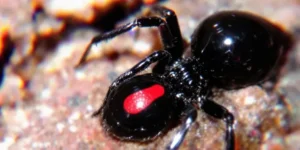Many people fear spiders, but the redback spider male often goes unnoticed. This tiny arachnid is just 3-4 mm long, much smaller than its female mate. This blog will provide information on this lesser-known spider’s life.
We’ll introduce you to a small but mighty Aussie creature!
Key Takeaways
- Male redback spiders are tiny, only 3-4 mm long, and light brown with white marks.
- During mating, male redbacks often somersault into the female’s mouth, with 66% becoming a meal for their mates.
- Redbacks live all over Australia and have spread to other countries like Japan and New Zealand.
- Female redbacks are bigger, live longer, and have more toxic venom than males.
- Since 1956, an antivenom has been used for redback bites, with about 250 people needing it each year in Australia.

Physical Appearance of the Male Redback Spider

Male redback spiders look quite different from their female counterparts. They’re much smaller, measuring only 3-4 mm in body length. That’s about the size of a grain of rice! These tiny arachnids sport a light brown colour with white markings, making them less eye-catching than the females.
Unlike the famous black and red females, male redbacks lack the striking red stripe on their back. Their bodies are more slender and less rounded. This smaller size and plain appearance often causes people to miss male redbacks in nature.
But these little guys play a crucial role in the species’ survival!
Unique Mating Behaviour
Male redback spiders have an unusual mating ritual. They perform a somersault into the female’s mouth during copulation. This behaviour is known as sexual cannibalism. Approximately 66% of males become a meal for their mates.
While dangerous, this act aids in passing on their genetic material.
Reproduction is challenging for male redbacks. The majority never encounter a female for mating. Under 20% of males successfully mate in their brief lifespans. Those that do mate often perish shortly after due to injuries.
If they utilise both their palps (mating organs) during copulation, they become infertile. These small arachnids face significant reproductive challenges.
Habitat and Distribution
Redback spiders are found throughout Australia. They prefer dry regions in South and Western Australia. These adaptable spiders have also established themselves in urban areas. They can be found in gardens, sheds, and even toilets in cities such as Brisbane and Perth.
These spiders have expanded beyond Australia’s borders. They have been transported to other countries. Redbacks are now present in Japan, the UAE, Belgium, New Zealand, and Iran. Urban development and land changes have facilitated the spiders’ expansion to new locations.
RedBackSpider.com observes that these versatile arachnids flourish in urban environments, making them a frequent sight in Australian cities.
Prey and Predators
Moving from their homes, we’ll examine the diet of redback spiders and their predators. These spiders are adept hunters. They capture insects, small lizards, and even other spiders in their adhesive webs.
The redback’s venom assists in immobilising its prey. Subsequently, it encases its catch in silk for future consumption.
Redbacks, however, aren’t always the apex predators. They face threats from their own predators. Black house spiders, cellar spiders, and giant daddy long-legs spiders often prey on redbacks.
White-tailed spiders and daddy-long-legs can even reduce redback populations in an area. These predators contribute to maintaining the redback population balance. It’s a challenging environment for these small arachnids, constantly searching for food while avoiding becoming prey themselves.
Supplementary Information on Male Redback Spider
Let’s examine the male redback spider more closely. We’ll explore some additional facts about this small arachnid.
Differences Between Male and Female Redback Spiders (Comparison Table)
Male and female redback spiders have some key differences. Here’s a quick look at how they compare:
| Feature | Male Redback Spider | Female Redback Spider |
|---|---|---|
| Size | 3-4 mm long | 10 mm long |
| Colour | Light brown with white marks | Black with red stripe |
| Lifespan | 6-7 months | 2-3 years |
| Time to mature | 45-90 days | 75-120 days |
| Venom | Less toxic | More toxic |
| Web-building | Rarely build webs | Build large, messy webs |
These traits show how male and female redback spiders differ. The females are bigger, live longer, and pose more risk to humans. Males are smaller and shorter-lived. Both play unique roles in their species’ survival. For more details on Australian spiders, visit RedBackSpider.com.
Venom and Human Interaction
Moving from the differences between male and female redback spiders, let’s examine how their venom affects humans. Redback spider venom is highly potent. It contains a neurotoxin that causes latrodectism, a set of symptoms resulting from their bite.
People who are bitten may experience pain, excessive sweating, nausea, vomiting, and distress. Since 1956, an antivenom has been available for redback spider bites. Approximately 250 people in Australia require this antivenom annually.
Fortunately, no fatalities have been recorded from a redback bite since the antivenom’s introduction. However, a 2014 study suggested the antivenom might not be more effective than a placebo.
This indicates that further research is needed regarding the treatment of these bites.
Images and Impact of Redback Spider Bites
Redback spider bites can be severe. Most bites occur from December to April during warmer weather. The bite marks are often small and difficult to detect. The pain can persist for over 24 hours.
Approximately one-third of people experience systemic symptoms. Nearly half of all bites occur on hands or feet.
Children often require specialised care for redback bites. In Perth, 21% of children required antivenom. In Alice Springs, this figure was higher at 83%. These statistics indicate the seriousness of redback bites.
It’s crucial to recognise and treat these bites promptly. We’ll examine how to protect yourself from redback spiders in their environments.
Conservation Status and Threats
Redback spiders have limited natural predators in Australia. They flourish in human-created environments such as residences and gardens. Their expansion to other countries is concerning.
Redbacks have been unintentionally transported to New Zealand, Japan, and even England. This typically occurs when wood chips are exported.
Redbacks are indigenous to Australia. Historical records indicate their long-standing presence here. Modern construction has facilitated their wider distribution. This can pose challenges for local insects in new regions.
Pest management professionals and wildlife specialists work to prevent redbacks from negatively impacting other species. They strive to limit the spiders’ spread to new locations.
Redback Spider in Australia: What You Need to Know
RedBackSpider.com unveils crucial information about the redback spider in Australian environments. This blog is worth reading for its insights on pest control, spider web behaviour, and safety tips.
1. What Is the Red Back Spider?
A red back spider (one latrodectus hasselti species) has an abdomen often bearing a stripe on the upper side. It’s considered dangerous due to its potent venom that acts directly on the nerves.
2. How Do They Use Their Web?
A spider web is built in hiding places like sheds or under eaves, providing shelter. Redback spider webs can hold egg sac clusters, each containing around 250 eggs.
3. Is Antivenom Available?
Yes. Antivenom is available for those showing nausea and vomiting or severe pain from a bite. Seek medical help if limb swelling or local redness worsen.
4. Are They Related to a Black Widow Spider?
A redback is a relative of the redback spider within latrodectus species, akin to the black widow spider. Both feature an hourglass marking, though some redbacks have an absence of a red dorsal patch.
5. Where Are These Spiders Found?
Spiders are found across australia, sometimes in north and south america or the pacific islands after spread. Latrodectus hasselti is a distinct species with a red dorsal stripe on its abdomen.
6. What About a Spider Web?
They build their webs near corners, placing egg sac structures on the upper side of surfaces. A redback is one that uses slender legs to spin sticky threads.
7. How Does a Bite Affect You?
A bite site may swell with local sweating at bite. If bandage pressure is too tight, it might cause serious complications.
8. Are They Cannibalistic?
Cannibalistic behaviour occurs when a female spider is ready to mate. The male’s abdomen might end up in her fangs.
9. Could Venom Movement Be Deadly?
Redback venom can lead to symptoms such as nausea and vomiting or more serious issues. Males die after mating, and spiderlings are cannibalistic if resources are scarce.
10. Why Pest Control Matters
Spiders like the redback can be problematic if spider is found in your home. Timely removal helps reduce risk and keeps families safe.
Comparison Table: Redback Spider Features
| Feature | Notes |
|---|---|
| Abdomen | Often brownish with additional white or red stripes |
| Size of a Large Pea | Adult females sometimes reach 3 mm or more in body length |
| Hour-glass marking on the underside | Similar to a black widow spider |
| Cannibalistic | Females have been observed to cannibalistic males |
Key Takeaways:
- Redback spider is one of the latrodectus hasselti group
- Stripe on the upper abdomen or upper side helps identify them
- Antivenom and immediate care are vital for severe bites
- Keep an eye on egg sac structures in hiding places
Conclusion
The male redback spider is a small yet essential component of nature. Its unusual mating behaviour and diminutive size make it distinctive. Studying these spiders helps us understand the intricacy and wonder of our world.
Through research, we can improve conservation efforts for diverse species. These tiny creatures remind us that even the smallest organisms have significant roles in our planet’s ecosystem.
FAQs
1. What’s the deal with male redback spiders?
Well, mate, these little blokes are… fascinating. They’re tiny – way smaller than the females. But don’t let their size fool you! These fellas play a crucial role in the redback world. They’re known for their risky mating habits, often becoming a snack for their lady friends after the deed is done.
2. How do you spot a male redback?
Look for a small spider, about 3-4 mm long. He’s got a reddish-brown body, often with white markings. Unlike his missus, he doesn’t sport that famous red stripe. His legs are longer in proportion to his body, making him a nimble little acrobat in the web.
3. Are male redbacks dangerous to humans?
Nah, these little mates are pretty harmless to us. Their fangs are too small to cause any real drama. It’s the sheila spiders you’ve got to watch out for – they pack a nasty bite. The boys are more interested in finding a partner than picking fights with humans.
4. Where do these blokes hang out?
You’ll find male redbacks in the same spots as the females. They love dark, dry places – think sheds, garages, or under rocks in the garden. They’re spread all over Oz, but they’re not big fans of the cold. So, you’re more likely to bump into one in the warmer parts of the country.





